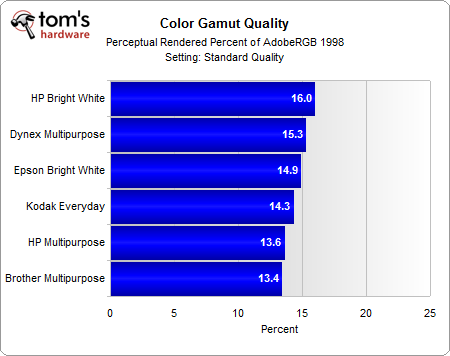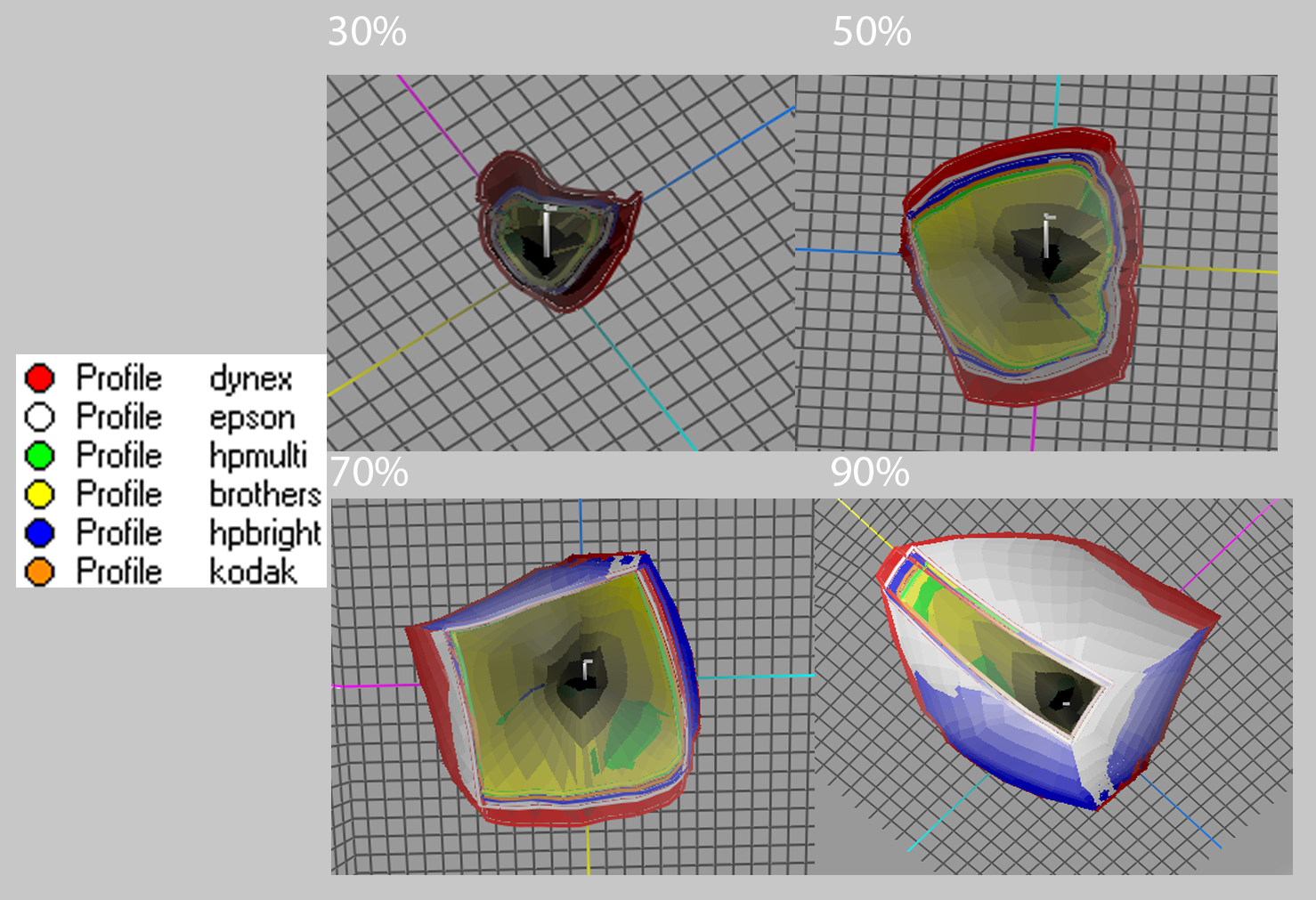Tom's Hardware Benchmarks Inkjet Printer Paper!
Do you own an inkjet printer? If you are concerned with the quality of your prints, you will want to read this article. We go over the technical differences between paper from Brother, Dynex, Epson, HP, and Kodak, and why one gets our recommendation.
Standard Print Quality: Color Gamut
In order to understand our results, you need to know how modern operating systems manage color. There is no printer (or monitor) in the world capable of reproducing all the colors we can see. On a computer, this problem is made more complicated since printers and monitors tend to have different strengths in color production. As a result, what you see on the screen is often different from what you print, and everything is different from the original picture that you took.
This is what professional photographers refer to as "gamut mismatch." If your monitor can't display all of the colors in a photo, you need to know which colors are out-of-gamut so that you don't incorrectly edit your picture. Operating systems like Windows 7 and OS X overcome this through a process called color management. The two major methods are known as perceptual and relative colorimetric rendering. Each places a different priority on how to render colors.
| Original Picture | 1 | 2 | 3 | 4 | 5 | 6 | 7 | 8 | 9 | 10 |
|---|---|---|---|---|---|---|---|---|---|---|
| Relative Colorimetric Rendering (mapping to 3-8) | 3 | 3 | 3 | 4 | 5 | 6 | 7 | 8 | 8 | 8 |
| Perceptual Colorimetric Rendering (mapping to 3-8) | 3 | 3.33 | 3.66 | 4 | 5 | 6 | 7 | 7.33 | 7.66 | 8 |
We'll use numbers instead of color hues because they're easier to understand. Say you have 10 shades of blue in a picture, 1 being the lightest and 10 being the darkest. If your printer can only print hues 3-8, you have to either toss out the other hues or change the color scale. Relative colorimetric rendering maps all the out of gamut colors to the extreme ends. This means that 3 represents any hue less than 3. Perceptual relies more on scaling. Instead of truncating color data, it maps on the same scale. Since the original picture had 10 shades of blue, it manipulates the extreme ends to make sure there are still 10 shades of blue.
Perceptual colorimetric rendering is vastly more complicated than relative, so don't assume that all of the middle hues go unmolested. The final result depends on the color management module (Adobe ACE, Microsoft ICM, and Apple ColorSync). In a nutshell, relative rendering destroys color information that cannot be displayed, while perceptual rendering compresses the information.
Neither rendering method is superior. Professional photographers have uses for each. However, on a day-to-day basis, you'll generally deal with perceptual rendering. That's how we are treating the color management of our paper samples. In order to see how each paper performs, we map the perceptual gamut (solid volume) in LAB space so that we can identify areas where the color gamut is mismatched. The wire form outline in each video represents the total gamut volume of AdobeRGB 1998.
HP’s Bright White performs the best out of all the printer papers, and Brother’s Multipurpose performs the worst.
Surprisingly, Dynex (Best Buy’s store brand) performs the second-best in terms of perceptual gamut volume. The difference is obvious once we look at profile slices. At 30% luminance, Dynex produces better magenta, blue, and cyan shadows. Dynex continues to hold a strong advantage up until about 60% luminance. We can clearly see a wider production of magenta, cyan, and yellow midtones, while the Bright White paper from Epson and HP both produce strong blue and cyan highlights.
Current page: Standard Print Quality: Color Gamut
Prev Page Ink, Color Gamut, And Test Method Next Page High Print Quality: Color GamutGet Tom's Hardware's best news and in-depth reviews, straight to your inbox.
-
iam2thecrowe I was kind of in disbelief when I read this article. Its a good try....but far from what is seen in the real world. Speaking from a printer tech's point of view, I can tell you that using the wrong kind of paper in certain printers can give disasterous results. The ink can sit on top, smudge, bleed etc. The manufacturer designs consumer printers with presets for different paper types. The specific printer may put more or less ink, raise or lower the carriage depending on paper thickness, not to mention every manufacturer uses a different type of ink and will react differently with different paper. This article is leading people in the wrong direction. You will only get reliable results from your inkjet printer using the manufacturers correct spec paper and ink and correct settings in your printer driver. If you happen to find one that works well for you that is not stated in the manufacturers spec, then good for you, but don't complain if your prints come out like crap using the wrong paper.Reply -
acku Reply9514582 said:I was kind of in disbelief when I read this article. Its a good try....but far from what is seen in the real world. Speaking from a printer tech's point of view, I can tell you that using the wrong kind of paper in certain printers can give disasterous results. The ink can sit on top, smudge, bleed etc. The manufacturer designs consumer printers with presets for different paper types. The specific printer may put more or less ink, raise or lower the carriage depending on paper thickness, not to mention every manufacturer uses a different type of ink and will react differently with different paper. This article is leading people in the wrong direction. You will only get reliable results from your inkjet printer using the manufacturers correct spec paper and ink and correct settings in your printer driver. If you happen to find one that works well for you that is not stated in the manufacturers spec, then good for you, but don't complain if your prints come out like crap using the wrong paper.
That's very true when it comes to Photo Paper, but there are hundreds of attributes that matter. However, it is possible for brand B photo paper to be have more color gamut on brand A printer than brand A photo paper, if they're optimizing for color fastestness or water proofing.
This was a look at everyday paper where differences are negligible on between multiple brands. We got the same results on Epson, HP, Brother, and Kodak printers. We know there are and we have seen different results with Photo Paper. Such as Canon Photo Paper behaving differently on a Canon printer, Epson printer etc....
I have benchmarks from about 10 more printers of varying brands that line up with the results from the MG5220. For the sake of simplicity, we only presented one.
Cheers,
Andrew Ku
TomsHardware.com -
The prices of the HP Bright White and Multipurpose are switched between the first and last pages of this article. At first I thought that the Bright White was both the best of the bunch and one of the cheapest, which left me wondering if the ink fumes had made the reviewer a little woozy when I saw that the multipurpose got the recommendation.Reply
-
acku ReplyThe prices of the HP Bright White and Multipurpose are switched between the first and last pages of this article. At first I thought that the Bright White was both the best of the bunch and one of the cheapest, which left me wondering if the ink fumes had made the reviewer a little woozy when I saw that the multipurpose got the recommendation.
I think magic markers smell better. :kaola: Fixed! -
acku Reply9514586 said:Seriously? You are benchmarking PAPER? Does the word "obsessive" mean anything to you?
Maybe more neurotic than obsessive. -
iam2thecrowe ackuThat's very true when it comes to Photo Paper, but there are hundreds of attributes that matter. However, it is possible for brand B photo paper to be have more color gamut on brand A printer than brand A photo paper, if they're optimizing for color fastestness or water proofing. This was a look at everyday paper where differences are negligible on between multiple brands. We got the same results on Epson, HP, Brother, and Kodak printers. We know there are and we have seen different results with Photo Paper. Such as Canon Photo Paper behaving differently on a Canon printer, Epson printer etc....I have benchmarks from about 10 more printers of varying brands that line up with the results from the MG5220. For the sake of simplicity, we only presented one.Cheers,Andrew KuTomsHardware.comThanks for clarifying that. Just didnt want people to get the wrong idea.Reply -
nebun ackuMaybe more neurotic than obsessive.it is good....we need to know who manufacures the best paper if we want our prints to last us a lifetime :)Reply

